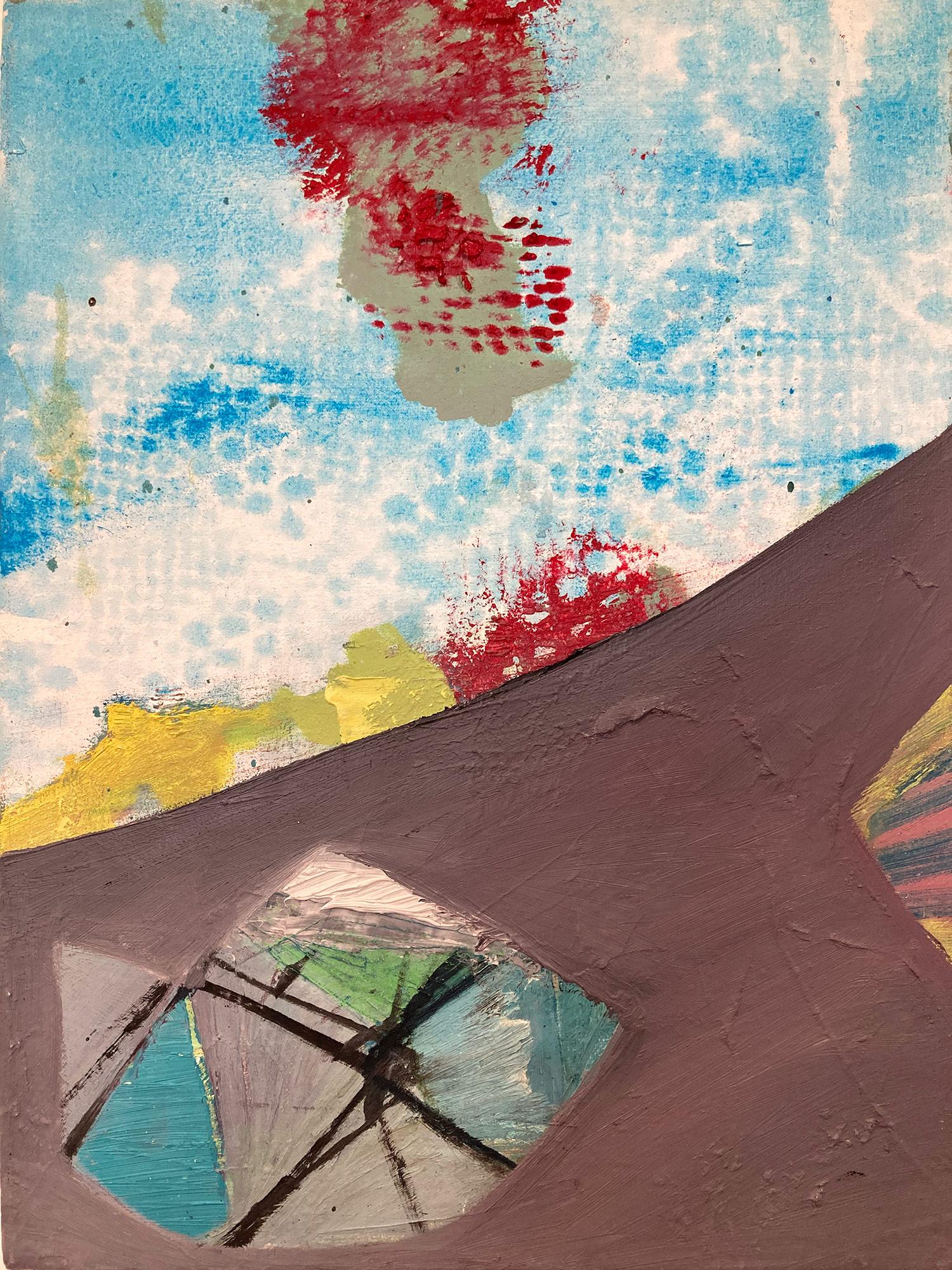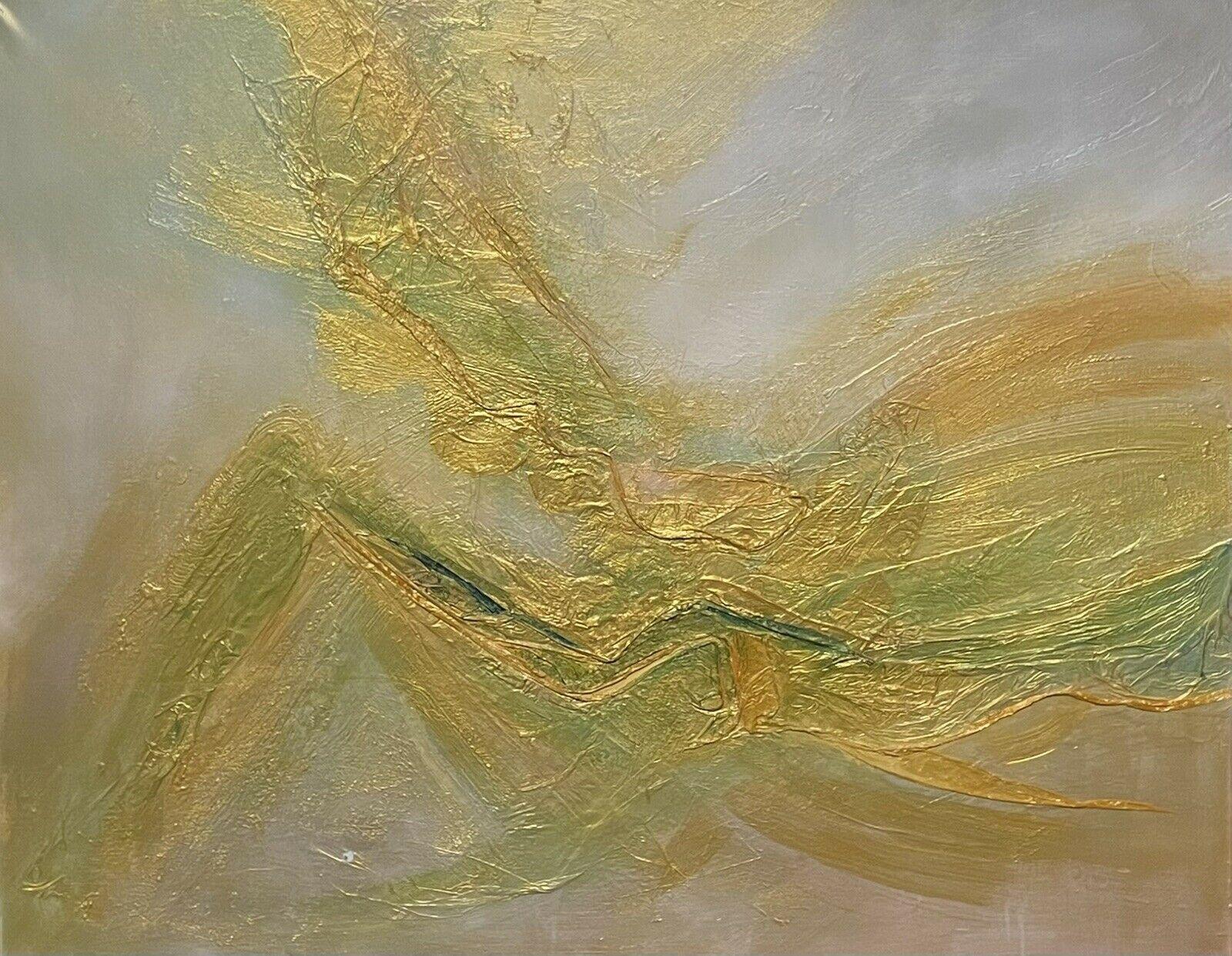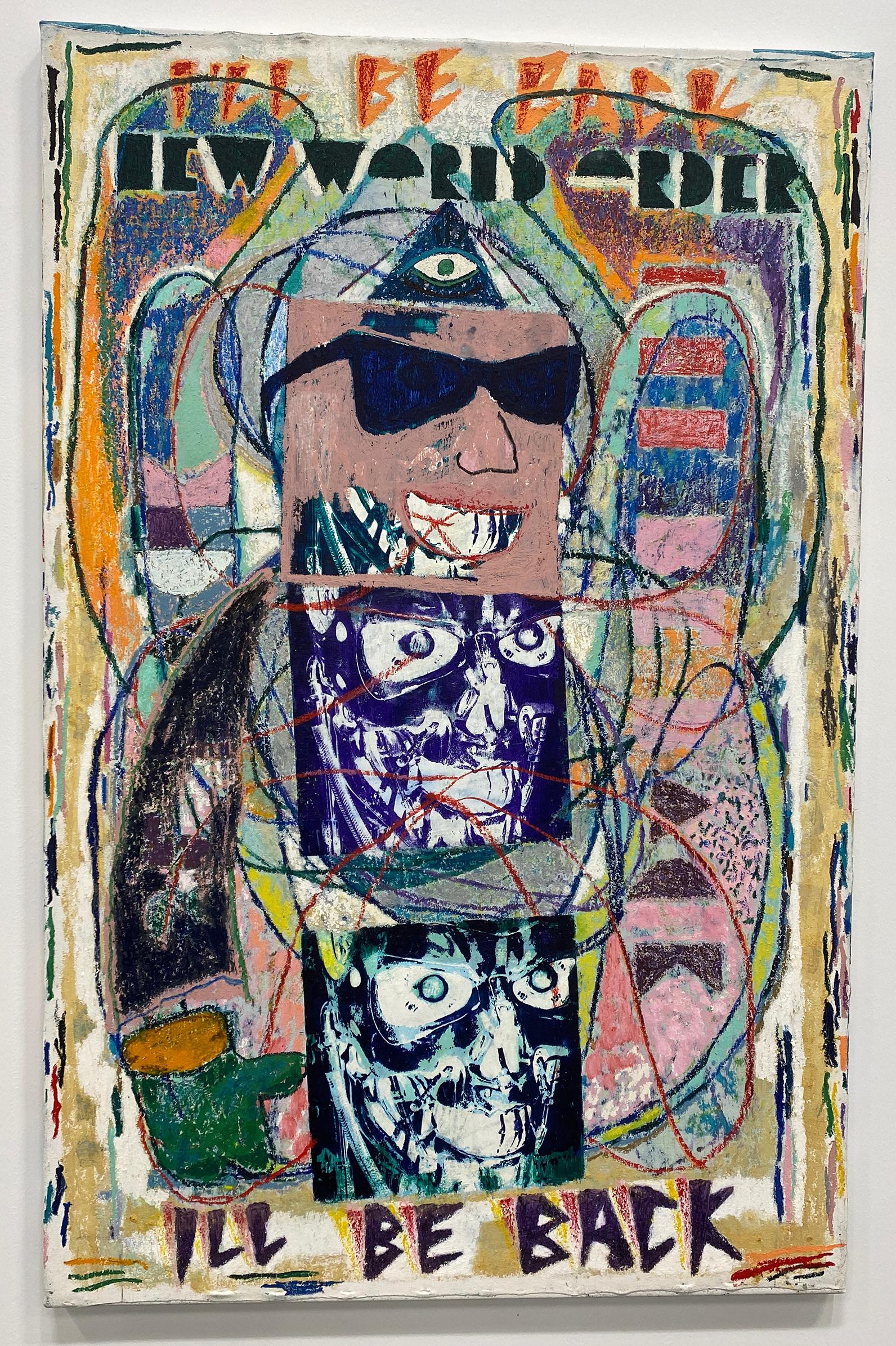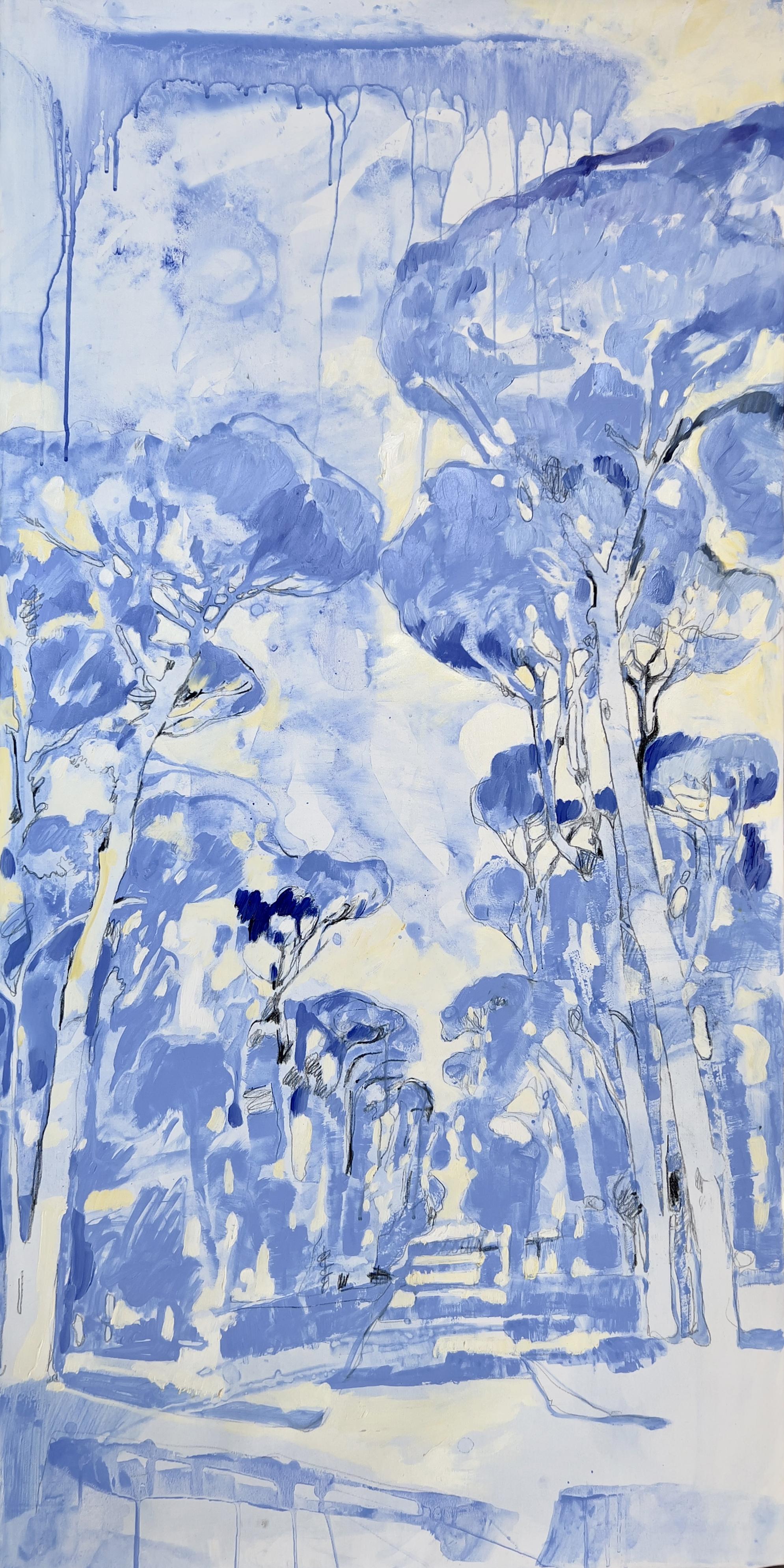Items Similar to Abstract Expressionist Art Latin American Mixed Media Oil Painting Perez Celis
Want more images or videos?
Request additional images or videos from the seller
1 of 20
Perez CelisAbstract Expressionist Art Latin American Mixed Media Oil Painting Perez Celis 1993
1993
About the Item
Perez Celis (American, Argentinian 1939-2008)
Oil and mixed media on canvas
1993
Latin abstract expressionism oil painting depicting a color block and drip motif
Hand signed and dated to lower left.
In gilt gold frame.
Approximate dimensions: canvas h. 14", w. 21"; frame h. 24", w. 31", d. 2.25".
Celis Pérez (1939 – 2008) was an Argentine artist usually referred to as Pérez Celis. He earned international recognition for his paintings, sculptures, murals and engravings.
Pérez was born in San Telmo on the South side of Buenos Aires, and grew up in Liniers, on the opposite end of town. Working as a newsboy during childhood, he learned the basics of drawing and painting via correspondence classes. In 1954 he entered the Manuel Belgrano National School of Fine Arts, and under the guidance of teachers like Leopoldo Presas, Santiago Cogorno, and Libero Badii, Pérez Celis developed his interest in abstraction. He first exhibited at age 17, at Galería La Fantasma. Following his entry into the professional arts world, he began using his name in a reversed form. At the start of his career he has been influenced by Hungarian artist Victor Vasarely during a 1957 retrospective of the latter's works at the National Fine Arts Museum. Some of his later works bear the influence of Gerhard Richter. He married Sarah Fernández in 1959 and relocated to Uruguay for less than a year invited by Carlos Páez Vilaró . Took part in the "Group of 8" – proponents of abstract art among the normally conservative local audiences.
"Grupo de los 8", was a movement of Latin American, Uruguayan and Argentine artists formed in 1958 together with Oscar García Reino, Miguel Ángel Pareja, Raúl Pavlovsky, Lincoln Presno, Américo Sposito, Alfredo Testoni and Julio Verdie in order to promote new tendencies in painting. In 1960 they were invited by art critic Rafael Squirru to join the international exhibition at the Buenos Aires Museum of Modern Art (of which he was creator and first director) with artists such as Willem de Kooning, Roger Hilton and Lucio Fontana. He returned to Buenos Aires in 1960, and opened a downtown atelier with the support of Guido Di Tella, his first mecena.
Pérez Celis explored geometric art, and builds his first mural, Fuerza América, in 1962. Indigenous patterns and colors would reappear in many of his productions during the 1960s and 1970s, and distinguished him from most other local artists, among whom pop art and figurative art was more influential.
His work had a more raw, Art Brut , Brutalist feel to it. He was featured in more than 120 solo shows during his career, notably the Galerie Bellechasse, Anita Shapolsky Gallery New York, (he showed with Agustin Fernandez, Rodolfo Abularach, Giancarlo Puppo and Cuban artist Mario Bencomo) Arteconsult, Boston & Panama, Witcomb, etc. and his art was purchased for many private collections and first-rate museums, including the Museum of Modern Art in New York. He received commissions from the Argentine government, which placed his works in the Ministro Pistarini International Airport, from other governments, and from prominent individuals and businesses.
In 1977, following his wife's passing in an automobile accident he remarried and lived in Caracas, Paris, New York City, and Miami in subsequent years. He shared his time between Buenos Aires and New York in 1994, a retrospective of his work was hosted at Biblioteca Nacional visited by more than 300000 persons. He continued exhibiting in Latin America, in the Sanyo Gallery in Tokyo, the Anita Shapolsky Gallery in New York City, and at numerous universities. Among his numerous recognitions in later years was the Alba Award at the 61st Salón Nacional de Artes Plásticas Argentino, and he was proclaimed a Distinguished Citizen of the City of Buenos Aires in 2001.
He also created several literary illustrations, notably those for Jorge Luis Borges' Spanish-language translation of Walt Whitman's poem Leaves of Grass. A fan of the Club Atlético Boca Juniors football team, he created two murals in 1997 for the team's La Bombonera Stadium in Buenos Aires: "Idolos" (Idols) and "Mito y Destino" (Myth and Destiny), both Venetian mosaics and bronze sculpture on cement.
Museum of Modern Art (MOMA), New York, NY
Museum of Modern Latin American Art, Washington D.C.
Museum of Modern Housatonic Art, Bridgeport, CT
Museum of Latin American Art, Los Angeles, CA
Museum of Syracuse University, NY
Art Museum of Philadelphia, PA
Library of Congress, Washington D.C.
The America's Collection, Miami, FL
Museum of Modern Art, Buenos Aires, Argentina
Museum of Modern Art, Bogotá, Colombia
Museum of Modern Latin American Art, Washington D.C.
Museum of Modern Art, La Paz, Bolivia
Fine Arts Museum of Posadas, Province of Misiones, Argentina
Emilio Pettoruti Museum, Asunción, Paraguay
Museum of Ciudad Bolívar
Museum of Contemporary Art, Panama City, Panama
Museum of Modern Art, Quito, Ecuador
Museum of Modern Latin American Art, Managua, Nicaragua
Museum of Modern Contemporary Art, San José, Costa Rica
Museum of Modern Housatonic Art, Bridgeport, Connecticut
Art Museum of Philadelphia, Pennsylvania
Museum of Syracuse University
Municipal Museum of Modern Art, Cuenca, Ecuador
Fine Arts Museum, Caracas, Venezuela
Fine Arts Museum of La Plata, Province de Bs. As.
Fine Arts Museum of Tandil, Province of Bs. As., Argentina
Fine Arts Museum of Rosario, Province of Santa Fe, Argentina
- Creator:Perez Celis (1939 - 2008, Argentinian)
- Creation Year:1993
- Dimensions:Height: 24 in (60.96 cm)Width: 31 in (78.74 cm)
- Medium:
- Movement & Style:
- Period:
- Condition:
- Gallery Location:Surfside, FL
- Reference Number:1stDibs: LU38212813442
About the Seller
4.9
Platinum Seller
These expertly vetted sellers are 1stDibs' most experienced sellers and are rated highest by our customers.
Established in 1995
1stDibs seller since 2014
1,566 sales on 1stDibs
Typical response time: 1 hour
- ShippingRetrieving quote...Ships From: Surfside, FL
- Return PolicyA return for this item may be initiated within 3 days of delivery.
More From This SellerView All
- Untitled Abstract Expressionist Painting Ojai California Artist Wesley JohnsonBy Wesley JohnsonLocated in Surfside, FLA listed California painter, muralist, and teacher, Wesley Johnson was born in Ojai, California in 1934, and educated at Ventura College and the University of California, Santa Barbara. He was also a pupil of Howard Warshaw and Andre L'Hote. The cubist style of Warshaw, combined with the airy and light feeling of impressionism and the abstraction of expression, influenced Johnson's style of painting. His paintings often contain large, sweeping strokes, but a subtle use of color that evocative of his spontaneous, non-objective style. Wesley Johnson is an Abstract Expressionist with strong influences from Cubism and Impressionism. His work has run the gamut from figurative murals painted on the commissary walls at Fort Ord, to large, colorful abstract oils...Category
20th Century Abstract Expressionist Abstract Paintings
MaterialsCanvas, Oil
- Abstract Expressionist Untitled CompositionBy Don FinkLocated in Surfside, FLDon Fink (1923-2010) was a well known and well listed Abstract Expressionist who studied at the Art Students League and the Academie Julien. He was bor...Category
20th Century Abstract Expressionist Abstract Paintings
MaterialsCanvas, Oil
- American Vivid Abstract Expressionist Art Oil Painting Norman Carton, WPA ArtistBy Norman CartonLocated in Surfside, FLNorman Carton (1908 – 1980) was an American artist and educator known for abstract expressionist art. He was born in the Ukraine region of Imperial Russia and moved to the United States in 1922 where he spent most of his adult life. A classically trained portrait and landscape artist, Carton also worked as a drafter, newspaper illustrator, muralist, theater set designer, photographer, and fabric designer and spent most of his mature life as an art educator. Carton showed in and continues to be shown in many solo and group exhibitions. His work is included in numerous museums and private collections throughout the world. Norman Carton was born in the Dnieper Ukraine territory of the Russian Empire in 1908. Escaping the turbulence of civil war massacres, he settled in Philadelphia in 1922 after years of constant flight. While attending the Pennsylvania Museum School of Industrial Art, Carton worked as a newspaper artist for the Philadelphia Record from 1928 to 1930 in the company of other illustrator/artists who had founded the Ashcan School, the beginnings of modern American art. From 1930 to 1935, he studied at the Pennsylvania Academy of Fine Arts under Henry McCarter, who was a pupil of Toulouse-Lautrec, Puvis de Chavanne, and Thomas Eakins. Arthur Carles, especially with his sense of color, and the architect John Harbison also provided tutelage and inspiration. Following his time at the Pennsylvania Academy of Fine Arts, Carton studied at the Barnes Foundation from 1935 to 1936 where he was influenced by an intellectual climate led by visiting lecturers John Dewey and Bertrand Russell as well as daily access to Albert C. Barnes and his art collection. Carton was awarded the Cresson Traveling Scholarship in 1934 which allowed him to travel through Europe and study in Paris. There he expanded his artistic horizons with influences stemming from Henri Matisse, Pablo Picasso, Chaim Soutine, and Wassily Kandinsky. While at the Pennsylvania Academy of Fine Arts, Carton was also awarded the Toppan Prize for figure painting as well as the Thouron Composition Prize. He received numerous commissions as a portrait artist, social realist, sculptor, and theatrical stage designer as well as academic scholarships. During this time, Carton worked as a scenery designer at Sparks Scenic Studios, a drafter at the Philadelphia Enameling Works, and a fine art lithographer. From 1939 to 1942, the Works Progress Administration (WPA) Federal Art Project employed Carton as a muralist and easel artist. He collaborated with architect George Howe. The WPA commissioned Carton to paint major murals at the Helen Fleischer Vocational School for Girls in Philadelphia, the Officers’ Club at Camp Meade Army Base in Maryland, and in the city of Hidalgo, Mexico. Throughout the 1940s, Carton exhibited and won prizes for his semi-abstract Expressionist and Surrealist paintings. He socialized with and was inspired by Émile Gauguin and Fernand Leger. During World War II, Carton was a naval structural designer and draftsman at the Cramps...Category
Mid-20th Century Abstract Expressionist Landscape Paintings
MaterialsCanvas, Oil
- American Vivid Abstract Expressionist Art Oil Painting Norman Carton, WPA ArtistBy Norman CartonLocated in Surfside, FLNorman Carton (1908 – 1980) was an American artist and educator known for abstract expressionist art. He was born in the Ukraine region of Imperial Russi...Category
Mid-20th Century Abstract Expressionist Landscape Paintings
MaterialsCanvas, Oil
- American Vivid Abstract Expressionist Art Oil Painting Norman Carton, WPA ArtistBy Norman CartonLocated in Surfside, FLNorman Carton (1908 – 1980) was an American artist and educator known for abstract expressionist art. He was born in the Ukraine region of Imperial Russia and moved to the United States in 1922 where he spent most of his adult life. A classically trained portrait and landscape artist, Carton also worked as a drafter, newspaper illustrator, muralist, theater set designer, photographer, and fabric designer and spent most of his mature life as an art educator. Carton showed in and continues to be shown in many solo and group exhibitions. His work is included in numerous museums and private collections throughout the world. Norman Carton was born in the Dnieper Ukraine territory of the Russian Empire in 1908. Escaping the turbulence of civil war massacres, he settled in Philadelphia in 1922 after years of constant flight. While attending the Pennsylvania Museum School of Industrial Art, Carton worked as a newspaper artist for the Philadelphia Record from 1928 to 1930 in the company of other illustrator/artists who had founded the Ashcan School, the beginnings of modern American art. From 1930 to 1935, he studied at the Pennsylvania Academy of Fine Arts under Henry McCarter, who was a pupil of Toulouse-Lautrec, Puvis de Chavanne, and Thomas Eakins. Arthur Carles, especially with his sense of color, and the architect John Harbison also provided tutelage and inspiration. Following his time at the Pennsylvania Academy of Fine Arts, Carton studied at the Barnes Foundation from 1935 to 1936 where he was influenced by an intellectual climate led by visiting lecturers John Dewey and Bertrand Russell as well as daily access to Albert C. Barnes and his art collection. Carton was awarded the Cresson Traveling Scholarship in 1934 which allowed him to travel through Europe and study in Paris. There he expanded his artistic horizons with influences stemming from Henri Matisse, Pablo Picasso, Chaim Soutine, and Wassily Kandinsky. While at the Pennsylvania Academy of Fine Arts, Carton was also awarded the Toppan Prize for figure painting as well as the Thouron Composition Prize. He received numerous commissions as a portrait artist, social realist, sculptor, and theatrical stage designer as well as academic scholarships. During this time, Carton worked as a scenery designer at Sparks Scenic Studios, a drafter at the Philadelphia Enameling Works, and a fine art lithographer. From 1939 to 1942, the Works Progress Administration (WPA) Federal Art Project employed Carton as a muralist and easel artist. He collaborated with architect George Howe. The WPA commissioned Carton to paint major murals at the Helen Fleischer Vocational School for Girls in Philadelphia, the Officers’ Club at Camp Meade Army Base in Maryland, and in the city of Hidalgo, Mexico. Throughout the 1940s, Carton exhibited and won prizes for his semi-abstract Expressionist and Surrealist paintings. He socialized with and was inspired by Émile Gauguin and Fernand Leger. During World War II, Carton was a naval structural designer and draftsman at the Cramps Shipbuilding Corporation in Camden, New Jersey. Here, he created non-objective sculpture with metal. After the war, Carton co-founded a fabric design plant in Philadelphia. He produced hand-printed fabrics for interiors and fashion that were featured in Harper’s Bazaar, Vogue and Women’s Wear Daily. Original fabric designs were commissioned by notable clients including Lord & Taylor, Gimbels, and Nina Ricci. Some of these designs are at the Metropolitan Museum of Art. Carton traded his partnership in the fabric design company in 1949 to focus full-time on painting. Carton had his first solo exhibition in 1949 at the Philadelphia Art Alliance. This show was followed closely by solo exhibitions at the Laurel Gallery (New York City) and Dubin Gallery (Philadelphia). At this time, his exhibited work was Abstract impressionism. In addition to painting, he taught classes at the Philadelphia Museum of Art and was the Founder and first President of the Philadelphia chapter of Artist’s Equity Association. The Philadelphia Museum of Art and the organization of the National Museums of France commissioned Carton to travel to Europe, mainly France, in 1950 for a color photography study of continental masterpieces. He was granted access to study the restoration of the Mona Lisa and was one of the very few to be given permission to remove the painting from its frame. During his three year stay in Paris, he had solo exhibits at La Sorbonne and Gallery Rene Breteau and was in 15 group shows in Paris salons including Les Sur Independants, Salon d’Automne, and Realities Nouvelles. He also exhibited at the Musee d’Art Juif where he won the Prix d’Art. The Cercle Paul Valery twice sponsored Carton to present lectures at the Sorbonne. He conducted seminars at the Louvre for the Cercle Esthetique Internationale and taught classes in and directed stage and costume design for the Theatre de Recherche at the Paris Opera. Among his Paris artist colleagues were Chana Orloff, Earl Kerkam, Sam Francis, Claire Falkenstein, Lawrence...Category
Mid-20th Century Abstract Expressionist Landscape Paintings
MaterialsCanvas, Oil
- American Vivid Abstract Expressionist Art Oil Painting Norman Carton, WPA ArtistBy Norman CartonLocated in Surfside, FLNorman Carton (1908 – 1980) was an American artist and educator known for abstract expressionist art. He was born in the Ukraine region of Imperial Russia and moved to the United States in 1922 where he spent most of his adult life. A classically trained portrait and landscape artist, Carton also worked as a drafter, newspaper illustrator, muralist, theater set designer, photographer, and fabric designer and spent most of his mature life as an art educator. Carton showed in and continues to be shown in many solo and group exhibitions. His work is included in numerous museums and private collections throughout the world. Norman Carton was born in the Dnieper Ukraine territory of the Russian Empire in 1908. Escaping the turbulence of civil war massacres, he settled in Philadelphia in 1922 after years of constant flight. While attending the Pennsylvania Museum School of Industrial Art, Carton worked as a newspaper artist for the Philadelphia Record from 1928 to 1930 in the company of other illustrator/artists who had founded the Ashcan School, the beginnings of modern American art. From 1930 to 1935, he studied at the Pennsylvania Academy of Fine Arts under Henry McCarter, who was a pupil of Toulouse-Lautrec, Puvis de Chavanne, and Thomas Eakins. Arthur Carles, especially with his sense of color, and the architect John Harbison also provided tutelage and inspiration. Following his time at the Pennsylvania Academy of Fine Arts, Carton studied at the Barnes Foundation from 1935 to 1936 where he was influenced by an intellectual climate led by visiting lecturers John Dewey and Bertrand Russell as well as daily access to Albert C. Barnes and his art collection. Carton was awarded the Cresson Traveling Scholarship in 1934 which allowed him to travel through Europe and study in Paris. There he expanded his artistic horizons with influences stemming from Henri Matisse, Pablo Picasso, Chaim Soutine, and Wassily Kandinsky. While at the Pennsylvania Academy of Fine Arts, Carton was also awarded the Toppan Prize for figure painting as well as the Thouron Composition Prize. He received numerous commissions as a portrait artist, social realist, sculptor, and theatrical stage designer as well as academic scholarships. During this time, Carton worked as a scenery designer at Sparks Scenic Studios, a drafter at the Philadelphia Enameling Works, and a fine art lithographer. From 1939 to 1942, the Works Progress Administration (WPA) Federal Art Project employed Carton as a muralist and easel artist. He collaborated with architect George Howe. The WPA commissioned Carton to paint major murals at the Helen Fleischer Vocational School for Girls in Philadelphia, the Officers’ Club at Camp Meade Army Base in Maryland, and in the city of Hidalgo, Mexico. Throughout the 1940s, Carton exhibited and won prizes for his semi-abstract Expressionist and Surrealist paintings. He socialized with and was inspired by Émile Gauguin and Fernand Leger. During World War II, Carton was a naval structural designer and draftsman at the Cramps...Category
Mid-20th Century Abstract Expressionist Landscape Paintings
MaterialsCanvas, Oil
You May Also Like
- Untitled Abstract Painting by Abdel Aziz Lourhraz, Mixed Media, Oil on CanvasLocated in New York, NYUntitled Abstract Painting by Abdel Aziz Lourhraz Mixed media, oil on canvas The abstract expressionist paintings of Abdel Aziz Lourhraz have an a...Category
2010s Abstract Expressionist Abstract Paintings
MaterialsCanvas, Paint, Mixed Media, Oil
- "Landscape Composition" Greek Abstract Expressionist Oil Painting on CanvasBy Eozen AgopianLocated in New York, NYThis piece is a bold display of Eozen Agopian's structurally strong pieces, with an intense color of Blue and green and pops of blue, red and white, mimi...Category
Early 2000s Abstract Expressionist Abstract Paintings
MaterialsCanvas, Oil, Mixed Media
- French Contemporary Abstract Painting Gold Highlights Expressionist CompositionLocated in Cirencester, GloucestershireArtist/ School: French expressionist/ abstract contemporary artist, 21st century Title: Abstract composition Medium: oil/mixed media painting on canvas, unframed. canvas: 25.75...Category
21st Century and Contemporary Abstract Expressionist Abstract Paintings
MaterialsOil, Canvas, Mixed Media
- 'I'll Be Back, ' by XVALA, Mixed Media PaintingBy XVALALocated in Oklahoma City, OK'I'll Be Back,' by XVALA is a mixed media painting and colorful screen print with iridescent oil stick painting featuring the theme of the 'New World Order.' It was produced in 2015/16. The phrase 'I'll Be Back' is printed on the top and bottom margins of the work with the words 'New World Order' on the top margin. Three heads are stacked in the center of the canvas with the 'all seeing eye' on the top of the head. XVALA's art illuminates the hidden fallout spawned from our high tech Internet age. His 'Fear Google' campaign exposed the decay of privacy and 'No Delete' used hacked nude celebrity photos to highlight loss of control over personal information. The artist has worked with trash from the homes of Mark Zuckerberg, Steve Jobs, and others, as well as dirt from the graves of George Orwell and Aldous Huxley. The dirt appears in the New World Order collection as part of a pyramidal, 3D printed, living ant farm...Category
2010s Abstract Expressionist Figurative Paintings
MaterialsCanvas, Mixed Media, Screen, Oil
- Pine trees 011By Laura FedericiLocated in Roma, RMLaura Federici lives and works in Rome. However, she traveled often to Syria, where she participated in exhibitions and workshops held in Damascus and Aleppo. She has exhibited widel...Category
2010s Abstract Expressionist Landscape Paintings
MaterialsOil, Gouache, Canvas, Paint, Mixed Media, Acrylic
- Subway Sonnet 120 - Mixed Media Soft Neutral Abstract Expressionism PaintingBy Susan WashingtonLocated in Los Angeles, CAThe surfaces Susan Washington works with are derived from her memories of the graffitied subway car, public telephone booths, and rolling steel cages that secure neighborhood stores ...Category
21st Century and Contemporary Abstract Expressionist Abstract Paintings
MaterialsCanvas, Mixed Media, Oil, Spray Paint
Recently Viewed
View AllMore Ways To Browse
Literary Art
Oil Business Art
Oil Paintings Of The American South
Latin American Paintings
Santa Fe Art Galleries
Airport Art
Latin American Artists
17c Art
American Government
Modern Abstract Expressionist Oil Paintings
1960s Expressionist Paintings
1960s Abstract Expressionist Painting
Modern Art Mural Abstract
Automobile Art
Abstract Cuban
Cuban Abstract Art
San Jose Oil Painting
Drip Painting Modern



